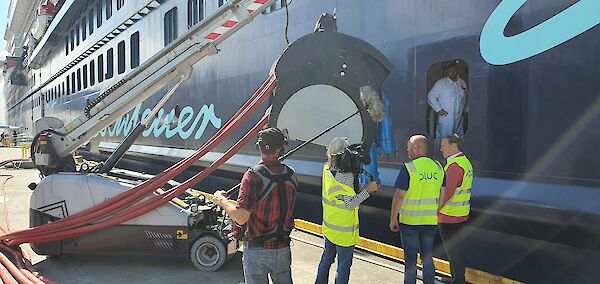Thursday, February 15, 2024 - 10:31 by ce-press
In 2018, Bergen had its biggest cruise year with around 600,000 passengers spread over 336 calls, but behind the facade there were concerns both regarding the number of tourists and, at the same time, the emissions that cruiseships were contributing to the city centre.
“After that season, there were political discussions about what measures the city could take to better control the growing cruise tourism,” explains Nils Mollerup, commercial manager Port of Bergen. The result was a decision taken in the city parliament to implement limitations on the number of ships and passengers per day, but also a commitment to install onshore power supply (OPS) for cruiseships.
A few years earlier, the port had carried out a major investment and venture for OPS with regard to offshore-related ships, and was therefore already in the driver's seat regarding the establishment of shore power facilities.
The Port of Bergen had already started work on a tool that would measure emissions in the harbour in the form of the Environmental Port Index (EPI), “a tool that would prove to be absolutely crucial in order to implement the changes that were to come” says Mollerup.
In the winter of 2019, the cruise industry was informed about Bergen's major changes. “After many discussions between the cruiselines, the Bergen Municipality and the port, the operators came to an understanding that if Bergen was to be a cruise destination of the future, the measures that were being put in place had to be adhered to,” he explains.
These were a maximum of three ships/8,000 passengers a day; the implementation of EPI; the implementation of an incentive scheme based on the EPI score; opening of future bookings 30 months before the season; clear and stronger criteria for entering a booking year by year, for example Tier I, Tier II, OPS etc; and construction of shore power for cruiseships.
As far as the port was concerned, there was a clear understanding that “when demands are placed on the users of the port, it must also be made possible for the users to achieve their goals”. In other words, for the ships to be able to dock emission-free at the quay in Bergen, a large OPS facility had to be available so that eventually all ships could be connected to this facility at the same time.
Bergen is fortunate that there is a lot of green electricity available close to the harbour and hence any OPS facility. “The construction of such a facility was new for many companies, and it took time before the work was fully underway,” explains Mollerup.
Had it not been for the pandemic, the facility would have been ready for start-up in spring 2021, but as it was it came online with five connections points, three of which could be used simultaneously, in 2022 as the cruise business started to resume operations.
By 2023 a well-established OPS was in place. “Around 25% of the world's cruise fleet visited Bergen in 2023 [341 calls/630,000 passengers], and 25% of the calls were connected to shore power,” says Mollerup. The same number of calls are expected in 2024 with half expected to connect to the OPS.
For cruise companies booking calls in 2026, there is a requirement that the ship must be able to connect to shore power.
“Throughout these years, there has been much learning and many discussions with the entire industry. Now we see passengers demanding sustainable solutions and having a ship that is environmentally modern and calls at a zero-emission port has become a competitive advantage.
The discussions surrounding the impact of cruises on the local community have been significantly reduced, and Bergen Municipality is satisfied with having achieved a good balance between residents and industry. A good city to live in is a good city to visit,” concludes Mollerup.
